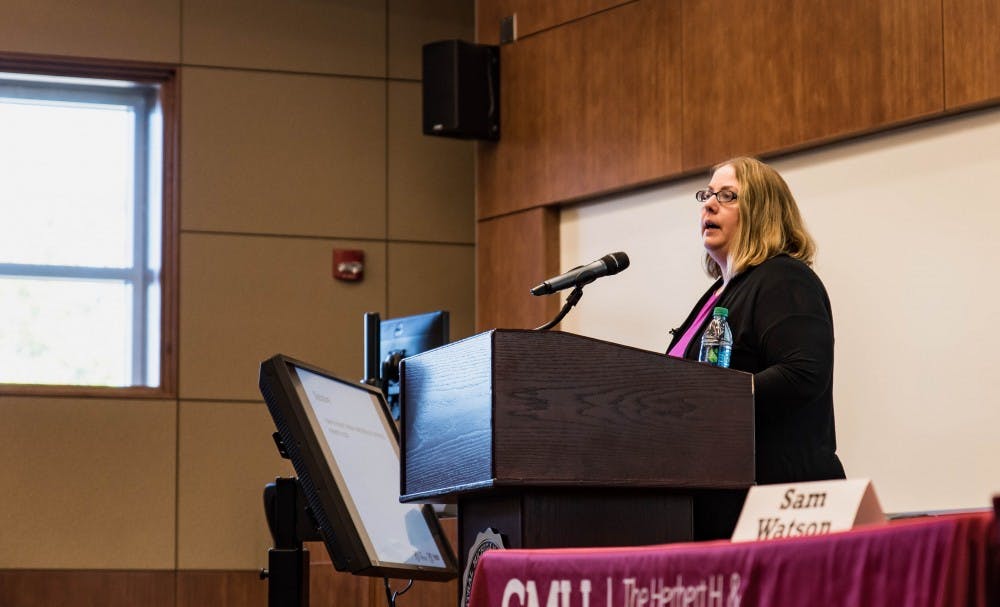College of Medicine conference promotes patient safety to current and future professionals
Present and future healthcare providers were urged by the College of Medicine speakers to expand patient safety measurements during the educational conference Wednesday, Oct. 4 in the Dow Chemical Company Foundation Auditorium.
During the conference titled "Safety Issues in Healthcare: Patients and Providers at Risk,” speakers laid out the imperative mission of healthcare professionals is to reduce error in patient treatment.
At the event, speakers addressed efforts being made to expand safety measurements throughout Michigan and around the world and explained medical error ranks third as the leading cause of death in the U.S. as of 2016.
Juliette Perzhinsky, associate program director of Internal Medicine, gave a presentation on teaching safety during residency training and throughout medical school.
The Accreditation Council of Graduate Medical Education (ACGME) released the Clinical Learning Environment Review (CLER) in 2013. Perzhinsky said the accreditation authorized an external pressure for students to have attain safety awareness and skills prior to program completion.
“In residencies and fellowship programs, you need to be able to show that you are building this culture of safety,” Perzhinsky said. “We actually need to start looking at the competencies of recognizing error and speaking up, and teaching our students and our residents to do that.”
Perzhinsky said she was motivated to give her presentation by her father’s death that took place about ten years ago due to a medical error.
“I take the credence that if I’m going to treat patients that I’m going to treat them as an extension of my family,” Perzhinsky said, adding that it's a devastation when patients are harmed or die due to indirect causes that could have been prevented by further awareness and precaution.
Adverse drug events, surgical site infections, ventilator-associated pneumonia and central line-associated bloodstream infection are among various medical errors that can result in death amongst patients. Hospital affections specifically affect 13 out of every 100 patients admitted into hospitals in the U.S.
“Hundreds and millions of patients are affected all over the world,” Marcia Novaretti, dean and professor at Nove De Julho University School of Medicine said.
Novaretti was present at the conference through a live video chat from Brazil.
"Patient safety is a serious global (and) public health issue because hospitals and healthcare facilities are not as safe as they should be,” Novaretti said, explaining that the issue of patient safety is an international concern.
Novaretti said her experiences and observations both in Brazil and the U.S. have confirmed that infection prevention and improvement measurements can reduce harm frequencies by 50 percent at simple and low costs.
Perzhinsky said the Swiss Cheese model of accident causation is an important guideline to follow as a healthcare provider working as part of a medical team.
The holes of a slice of swiss cheese represent an individual’s mistakes. When the slices are stacked together, the holes are filled by a bottom layer, eliminating the impact of one’s inaccuracies.
“When I’m in the clinic and I’m seeing 20 patients in a half day stacked in a resident clinic and I’m tired because my son was sick last night I may not be fully functional,” Perzhinsky said. “I’m relying on my resident, I’m relying on my nurse and the MA crew to be that layer of cheese to prevent errors from happening.”
The speakers said strengthening teamwork and infrastructure in the medical field can make tremendous modifications on patient safety.
Sam Watson of the Michigan Health and Hospital Association and vice president of patient safety and quality said expanding precaution and annihilating error begins with setting the message in all medical trainees and personnel.
He said nurses, physicians, pharmacists and any members of the health team must have a built in standard on avoiding mistakes in their profession.
“(It starts with) building safety as an expectation of what you do as part of the education. Doing it together instead of alone as medical school (and) nursing school (students),” Watson said.





